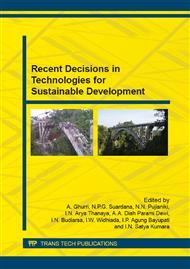p.24
p.30
p.36
p.41
p.47
p.53
p.59
p.66
p.74
Deformation Behavior of Concrete due to the Influence of the Steel Ring Width Variations as the External Confinement
Abstract:
Deformability of concrete decreases as its strength increases. The higher the concrete strength, the lower it’s failure strain which shows increase of brittleness. One way to improve the ductility and carrying capacity of concrete is by doing confinement of the concrete. A steel ring external confinement was used in this study. The steel ring is made of a steel cylindrical tube that is cut with a specific width (a) so similar to the ring. The steel ring is placed at a specific distance between the ring (b). With ring width variation (a = 28, 45 and 73 mm) and the distance between the steel ring is constant (b = 40 mm), gave the variation of the volumetric ratio which will afffect the confinement on the concrete. The test results showed that the steel ring was effective as external confinement of the concrete. The capability of concrete to support load increases in line with the width of the ring. Increased carrying capacity of concrete for 28, 45 and 73 mm ring width is respectively 115.382%, 131.792%, 150.253% and the maximum strain of concrete increases to 389.474%, 368.421% and 366.667%, respectively.
Info:
Periodical:
Pages:
47-52
Citation:
Online since:
July 2015
Authors:
Keywords:
Price:
Сopyright:
© 2015 Trans Tech Publications Ltd. All Rights Reserved
Share:
Citation:


